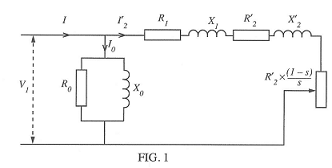Electrical Engineering Questions:
Q1. (a) Define the term 'slip' as applied to an induction motor.
(b) What is the operating speed of a 4-pole squirrel-cage induction motor fed from a 60 Hz supply if the slip is 4%?
Q2. Demonstrate that the relationship between total rotor power, rotor losses and the mechanical power generated, in terms of rotor current and resistance, by the rotor of an induction motor is of the form 1 : (1 - s) : s.
Q3. (a) State the formula for determining the synchronous speed of an induction motor.
(b) If a 6-pole induction motor is fed from a 50 Hz supply, what is its synchronous speed?
(c) What would be the supply frequency for the 6-pole motor of part (b) running at a speed of 1150 rev min-1 when fully loaded and the slip speed is 50 rev min-1?
Q4. A four-pole, star-connected, squirrel-cage induction motor operates from a variable voltage 50 Hz three-phase supply. The following results were obtained as the supply voltage was gradually reduced with the motor running on no-load.
|
Stator line voltage
|
220
|
164
|
112
|
88
|
42
|
|
Stator line current (amperes)
|
6.8
|
5.4
|
3.9
|
3.8
|
3.7
|
|
Stator power (watts)
|
470
|
360
|
278
|
244
|
232
|
(a) By plotting a suitable graph from these results, determine the total of windage and friction losses, the no load magnetising current I0 (assume no load current I0 is magnetising losses) and the equivalent circuit magnetising circuit parameters R0 and X0.
(b) With locked rotor and 50 volts applied to the stator, the current was 23 amperes and power input 985 watts. The resistance between two lines is 0.5 ohms.
If the rotor turns per phase equals the stator turns per phase, draw the equivalent circuit of the motor and determine the values of the various components. Assume the stator phase reactance is the same value as the rotor phase reactance.
The equivalent circuit is shown in FIGURE 1.

Q5. (i) State the methods used to obtain high starting torques in squirrel-cage induction motors and in wound rotor induction motors.
(ii) The frame of an induction motor is marked C225 MC. Describe the physical features of the motor.
(iii) Name the types of starter used with squirrel-cage motors.
(iv) State the main advantages of a squirrel-cage induction mote compared to a wound rotor machine.
Q6. (i) Describe an auto-transformer starter. From the expression for power input per phase (∞ torque) show that for a turn's ratio n of √3:1, for the auto-transformer:
- The power input to the motor/phase = Vs2Rp/n2Zp2.
- The motor starting torque = direct on-line torque/3.
- Using a star/delta starter the motor starting torque is the same as the auto-transformer above.
(ii) If a motor produces a starting torque of 70 Nm with a starting current of 55 amperes when controlled by a direct-on-line starter, what will be the starting torque and starting current when using a star/delta starter?
Q7. (i) Given that the rotor emf at any slip Er = sEo where Eo is the rotor phase voltage at standstill, show mathematically that for a 3 phase induction motor where R2 is the rotor phase resistance and X2 is the rotor phase reactance that:
(a) The rotor current per phase can be expressed as: Ir = sEo/√(R22+(sX2)2)
(b) The power factor is cosφ = R2/√(R22+(sX2)2).
(c) Power input per rotor phase can be expressed as: Power per phase = (s2Eo2R2)/(R22+(sx2)2).
(ii) If the torque output per phase is proportional to the power input per phase ignoring losses it can be shown that:
T ∝ sR2/(R22+(sX2)2)
then show by differentiating with respect to the slip s, that maximum torque occurs when: R2 = sX2
(iii) A two-pole wound rotor induction motor has a rotor resistance of 0.8 ohms per phase and a rotor leakage reactance of 7 ohms. At what speed will the motor produce maximum torque when fed from a 50 Hz supply? What resistance must be added to the rotor circuit to give maximum starting torque?